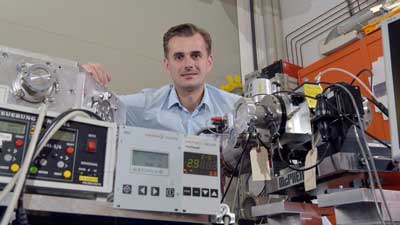| Jun 28, 2018 | |
New solar technology with 2D semiconductor nanomaterials(Nanowerk News) It is crucial that we prevent the Earth from warming by more than two degrees Celsius compared with the pre-industrial era. This is a key aim of the 2015 Paris Climate Agreement. To achieve this goal, greenhouse gas emissions have to be drastically reduced. And for this to happen, we need a global energy revolution, with fossil fuels such as oil, gas and coal being largely replaced by renewable energy sources. |
|
| So far, so obvious. However, it is well known that difficulties are being experienced in reaching these climate goals, and Dr Michael Zürch is certain that this is not just due a lack of political will. | |
| “It would definitely be possible to accelerate the energy transition if, for example, we had better solar technology,” says Zürch, a physicist who obtained his PhD at Friedrich Schiller University in Jena and has been doing research at the renowned University of California at Berkeley since 2015. He points out that the silicon-based solar modules currently in use have an efficiency of at most 20 per cent. | |
| In other words: with current modules, more than three-quarters of the solar energy cannot be used. “We need alternatives to silicon that enable a more efficient conversion of solar energy into electricity,” adds Zürch. | |
 |
|
| Dr Michael Zürch from the Institute of Optics and Quantum Electronics at the University of Jena investigates semiconductor materials to replace silicon in solar modules. (Photo: Jan-Peter Kasper/FSU) | |
| Over the next four years, Zürch will be focusing intensively on these alternatives. With colleagues at the Chair of Quantum Electronics of the University of Jena, as well as French and US partners, he is launching his ‘Quest for Energy’ research project. The German Academic Exchange Service is funding the project until 2022 with around one million euros, as part of the German-French research initiative ‘Make our planet great again’. | |
Two-dimensional semiconductor materials to replace silicon |
|
| A promising class of materials that could supersede silicon in solar modules is that of semiconductor nanomaterials, as Prof Christian Spielmann explains. “These two-dimensional layers, which are just a few atoms thick, possess quite extraordinary optical and electronic properties, which make them ideally suited as semiconductors,” adds Spielmann, in whose team Zürch’s project is now based. | |
| The best-known example of such 2D nanomaterials is graphene. However, the physicists in Jena want to explore a new class of these materials that has hardly been studied to date: transition metal dichalcogenides. | |
| “These are composite materials, the properties of which vary depending on their composition and which could therefore be tailored for use in a variety of applications,” Zürch explains. | |
| However, little is known so far about the fundamental processes in these materials when they interact with light. Due to their special nano-properties, the physical processes in these materials are especially fast. The physicists now want to investigate these properties in detail, to assess their suitability as a solar material. | |
| “Our specific aim is to observe the charge carriers – i.e. the electrons – in the material when they are illuminated with light.” This will be done with the help of a high-performance ultrashort pulse laser, which records the extremely rapid movements of the electrons in snapshots lasting only a few hundred attoseconds. An attosecond is one quintillionth of a second – the brief moment it takes for light particles to travel the length of a water molecule. | |
| The work of the Jena physicists will initially be “purely basic research”, notes Zürch. “However, in the long term this might enable us to smooth the way towards a targeted application of such composite materials in solar technology and actually move the energy transition forward.” |
| Source: Friedrich Schiller University Jena | |
|
Subscribe to a free copy of one of our daily Nanowerk Newsletter Email Digests with a compilation of all of the day's news. |
